Dissecting Champion Solar Cells - Advanced Loss Analysis Reveals Path to 27% Efficiency
Through rigorous loss analysis of Jinko Solar's record 26.7% TOPCon cells, ANU researchers have identified the key barriers to higher efficiency and mapped a clear pathway to 27%+ performance using advanced simulation tools to quantify optical, recombination, and resistive losses.

· Malcolm Abbott · 8 min read
At the 53rd IEEE PVSC conference (held June 2025 in Montreal Canada) the plenary for the crystalline silicon area was presented by Professor Daniel MacDonald from the Australian National University. He spoke about their long running collaboration with Jinko Solar and specifically about the state of high efficiency n-type solar cells. In this post, we will look at the part of that talk that examines Jinko’s record 26.7% TOPCon cells and the loss analysis that ANU and Jinko are using to understand and further improve those devices.
With permission from Dan MacDonald, we have recorded part of the talk and posted it at the bottom of this article. We’ve also included some of his slides in this article.
High efficiency n-type cells
In the silicon PV world, there are two main cell architectures that are competing to be the technology of choice to replace PERC. Both make use of n-type substrates, and both employ complex surface processing to improve efficiency. Below is Dan’s slide presenting a comparison between the two. On the left is the TOPCon and on the right is the silicon heterojunction cell or SHJ.
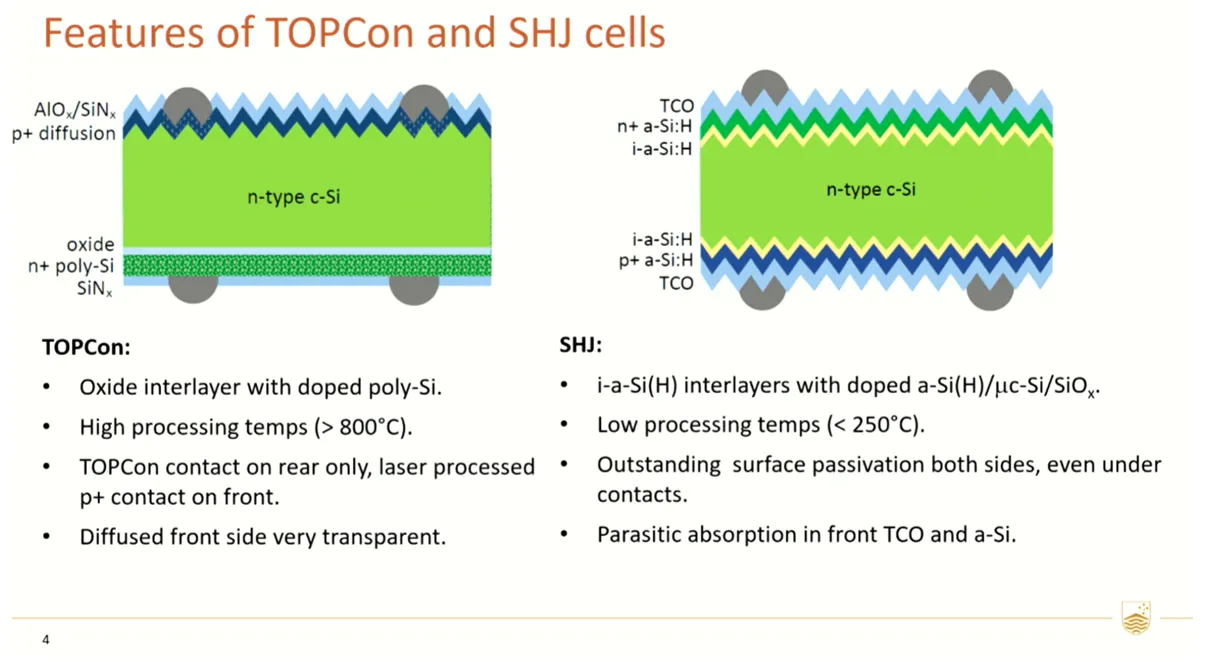
According to Dan, Jinko has focused on the TOPCon cell architecture, due to the robust nature of the process and the 2-3x reduction in CAPEX costs (i.e. it is easier and cheaper to build and run a TOPCon factory). In the early days this technology struggled with efficiency losses internally at the solar cell surfaces. However, the introduction of the LECO process to enhance the quality of metal contacts, and a reduction in p+ diffusion strength, has enabled very high performance. Dan reports that the boron emitter sheet resistance is now over 300 Ω/□ which is much more resistive than the old values that tended to be <100 Ω/□. These front surface regions are now optically high performing, low in minority carrier recombination, but high in lateral resistance. The chart below shows the increase over time of the cell open-circuit voltage (a proxy for electrical loss within the cell). This improvement has eroded the efficiency advantage for the SHJ. Interestingly Dan points out that the surface recombination in both TOPCon and SHJ is now so low that the devices are becoming limited by the intrinsic properties of the wafers themselves.
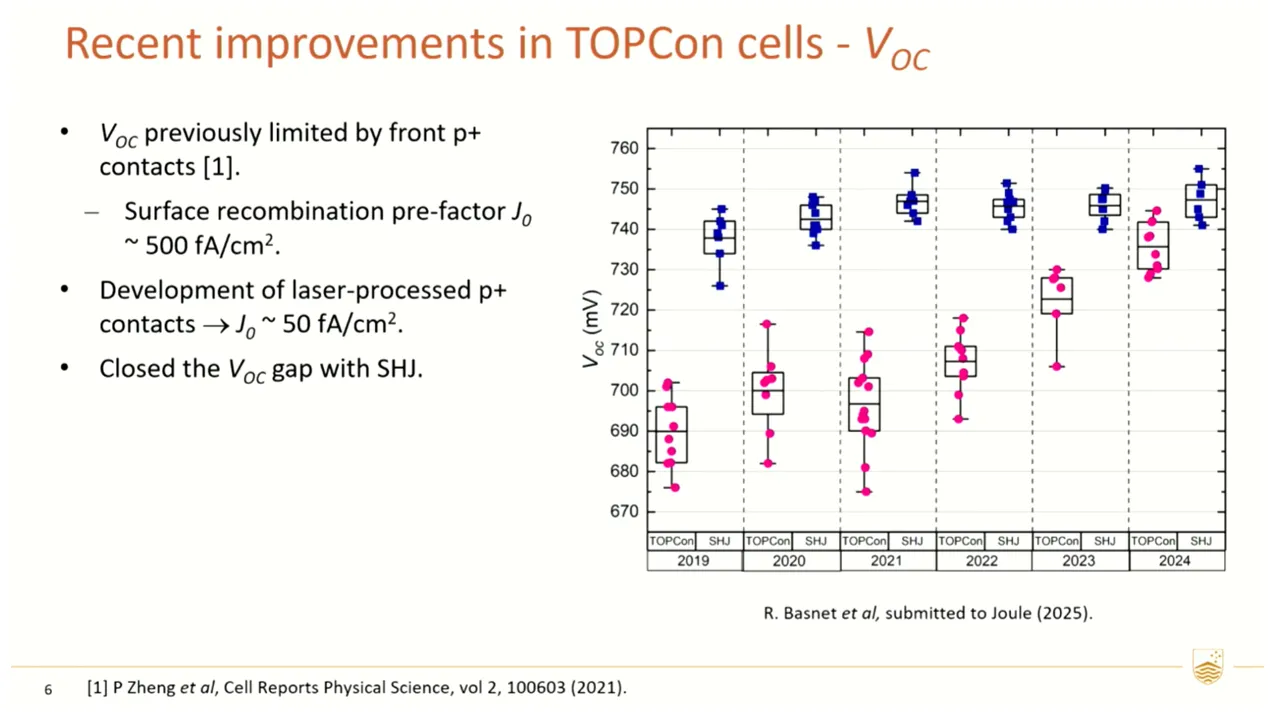
The outcome of these improvements is a startling high cell efficiency. In the case of Jinko they have demonstrated 26.7% large-area TOPCon cells. One key to achieving this, and to unlocking further improvements, has been rigorous loss analysis. Dan presented this in detail, and we have captured that part of his talk at the end of this post as it is well worth watching.
Dissecting the 26.7% Champion Cell
Solar cells either convert the incident energy to useful electrical energy, or they lose it somehow. To achieve higher efficiency, we need to pinpoint where the energy is being lost. The losses can be grouped into three categories .
- Optical: which is the energy not transferred from the incident photons into useful electrical carriers . These losses include reflection from the surfaces, parasitic absorption and the escape of weakly absorbed long wavelength light (which bounces around inside the cell and potentially escapes without being absorbed).
- Recombination: which is the electrical energy that does not exit the cell because useful charge carriers are trapped. These losses occur in the bulk semiconductor material and at the surfaces such as the contact points with the metal.
- Resistive: which are Ohmic losses where the collected charge carriers lose their energy to heat as they try to exit the cell. These losses are majority carrier losses and tend to occur in the metal electrodes, surface doped layers and laterally through the semiconductor itself.
How to quantify these losses and assign them to specific causes is a tricky business. It requires the use of advanced simulation tools. In the case of the work presented by ANU they have applied a waterfall approach for the optical losses in which they start with a well-developed baseline model and then systematically ‘fix’ parts of the device. The electrical and resistive losses were then determined at the maximum power point of the device under operation. The simulation tools used were SunSolve and Quokka.
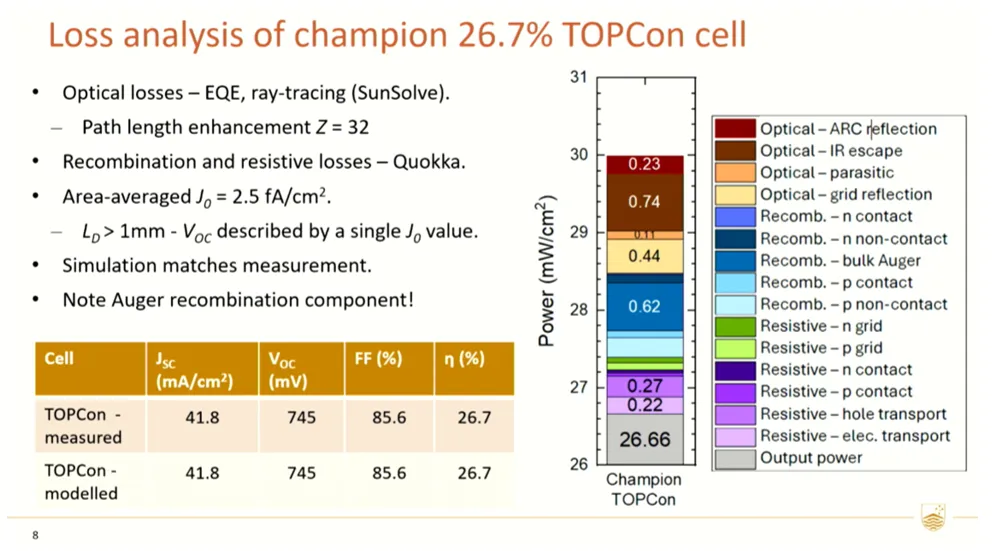
There is a lot of information on that slide so let’s go through some key takeaways. Firstly, the simulation model matches the measured model for the 26.7% solar cell. This has been achieved through both characterization of the device itself as well as the creation of various test structures to measure the individual components. This gives us confidence in the accuracy of the model.
Secondly, a trustworthy model allows us to quantify the losses in the 26.7% cell, as displayed in the bar chart. A key finding here is that the optical losses account for around half of all the remaining losses.
And thirdly, a trustworthy model allows us to test practical ways to reduce the losses. Dan concludes that this is possible with superior light-trapping (i.e. improved texture and improved scattering at the surfaces), less absorption in the poly-Si layer, and thinner fingers. SunSolve is ideally suited to exploring these types of improvements due to its complex optical models. For example, the parasitic losses in the poly-Si layers can be modeled using the free-carrier absorption models. And the scattering model for random pyramid texture is well documented in the literature.
We also learn that the recombination losses are dominated by bulk Auger (which is a fundamental property of the wafer and can only be modified by changes to bulk doping and wafer thickness). The next biggest recombination loss occurs in the surface regions that contain the p+ doping (i.e. the front surface emitter). Dan comments that in these devices the overall recombination is so low that, in effect, all the surface regions are electrically coupled together. This means that it is possible to model the total surface loss as a simple area-average of each of the regions (i.e. you can create an effective J0 for the surface by multiplying each region J0 by its fraction of area coverage).
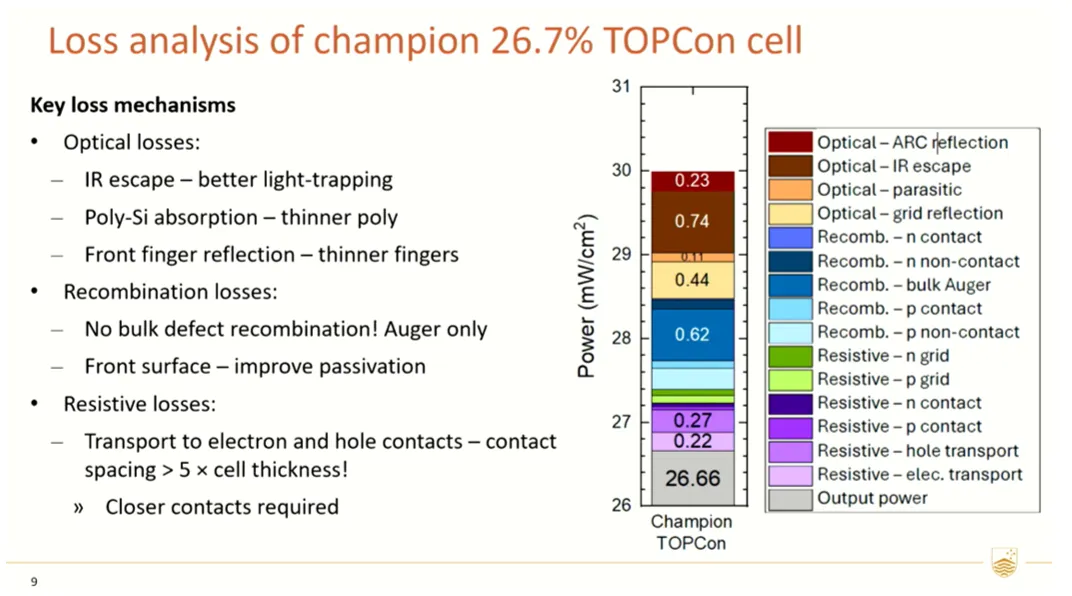
The final piece of the puzzle is the resistive losses. These entail the great trade-off when optimising the metal design and surface regions. The two big components are the hole and electron transport. This is the lateral flow of those carriers as they are transported to the metal fingers for extraction into the external circuit. Dan points out the surface films and diffused regions are not helping much as they are now so lightly doped. The solution will be closer contacts (or a transition to back contact cells, which is a blog post for another day). SunSolve includes an analytical grid model that accounts for the lateral resistive losses at the surfaces as well as in the metal grids themselves. This allows optimization of the design through simulation of the trade-off between optical loss and resistive loss.
With their well-tuned model, the team at ANU design a future TOPCon cell with an efficiency over 27.1%, which they expect to see within the 12 to 18 months.
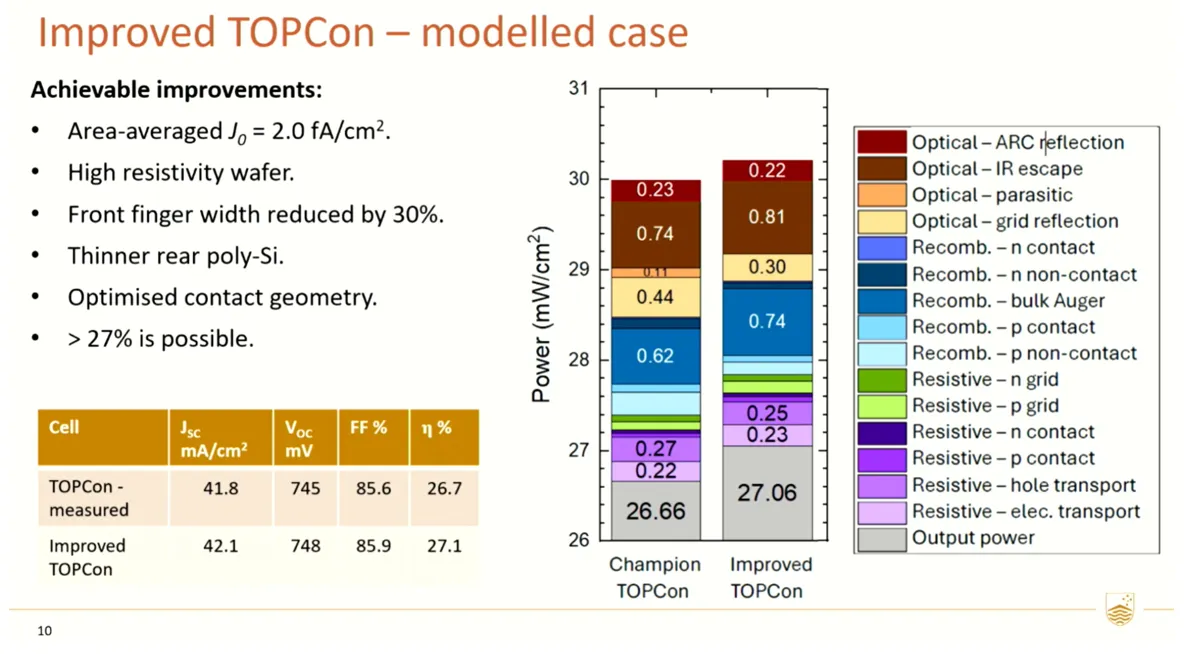
Driving Innovation Through Simulation
The work by the team at ANU and Jinko demonstrates the power of using simulation tools to understand and improve solar cells. It has highlighted the importance of optical losses as the main challenge to overcome. The trade-off between those losses and electrical resistance will be a major focus of work for these teams in the future.
SunSolve is the tool of choice for this work due to its complex optical model and ease of use. Other cell manufacturers such as Longi, Trina and many others are all using it to inform and improve their cell designs. If you would like to get a free trial of SunSolve then please Contact us and get started today.
Acknowledgments
Thanks to Dr Kean Fong from ANU for providing further details on his loss analysis and to Professor Dan MacDonald for allowing us to share his work.
This work and the work presented by ANU was supported by funding from the Australian Renewable Energy Agency (ARENA). The views expressed herein are not necessarily the views of the Australian Government, and the Australian Government does not accept responsibility for any information or advice contained herein.
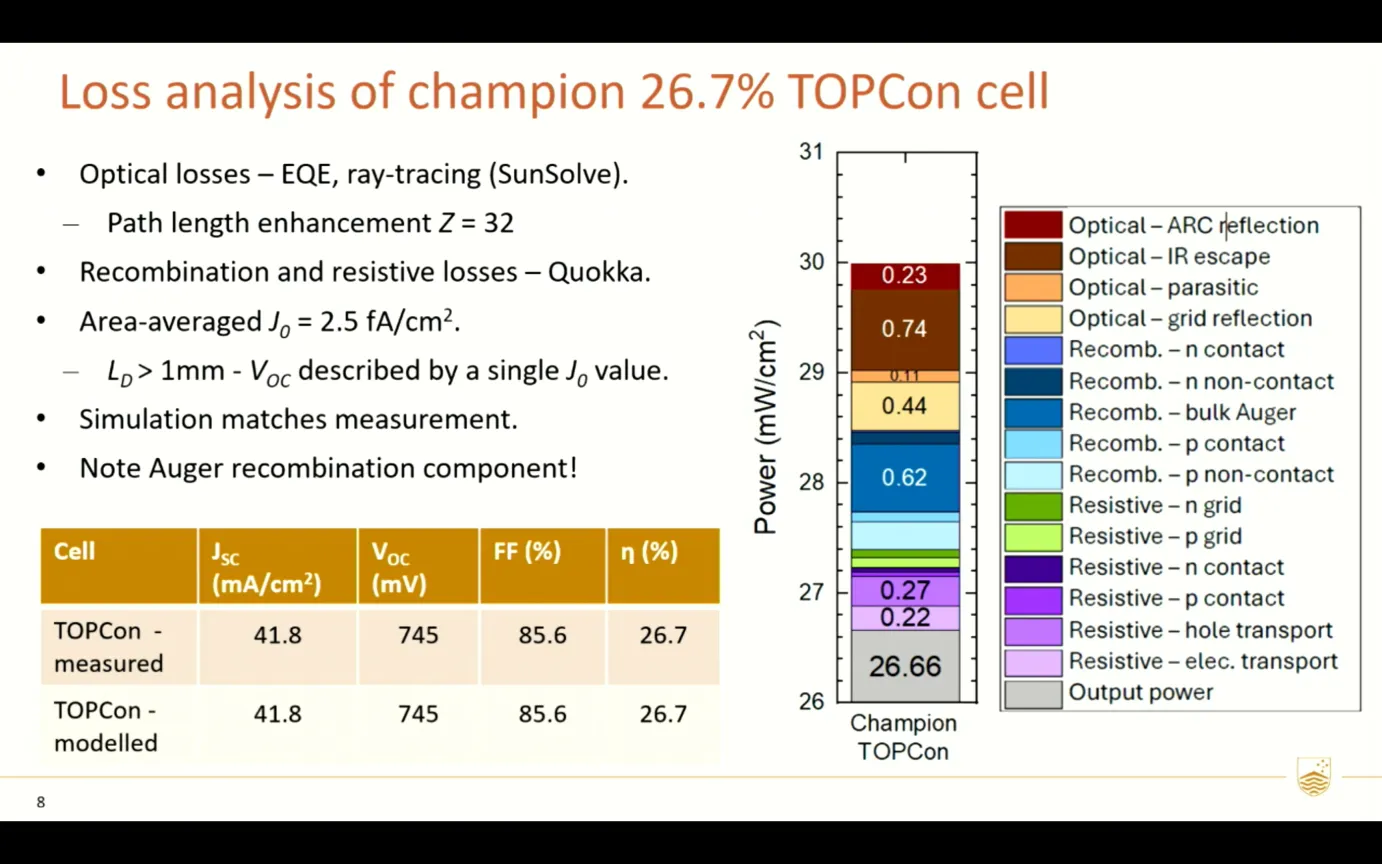 Click the image above to view part of Professor Daniel MacDonalds plenary talk from the 53rd IEEE PVSC.
Click the image above to view part of Professor Daniel MacDonalds plenary talk from the 53rd IEEE PVSC.
Update
It seems that Dan’s predictions regarding the future cell efficiency were correct, although perhaps his estimates of when it would become reality were slightly conservative. Since his talk and the writing of this blog post, Jinko Solar have announced a new record for their large area TOPCon cells of 27.0%.